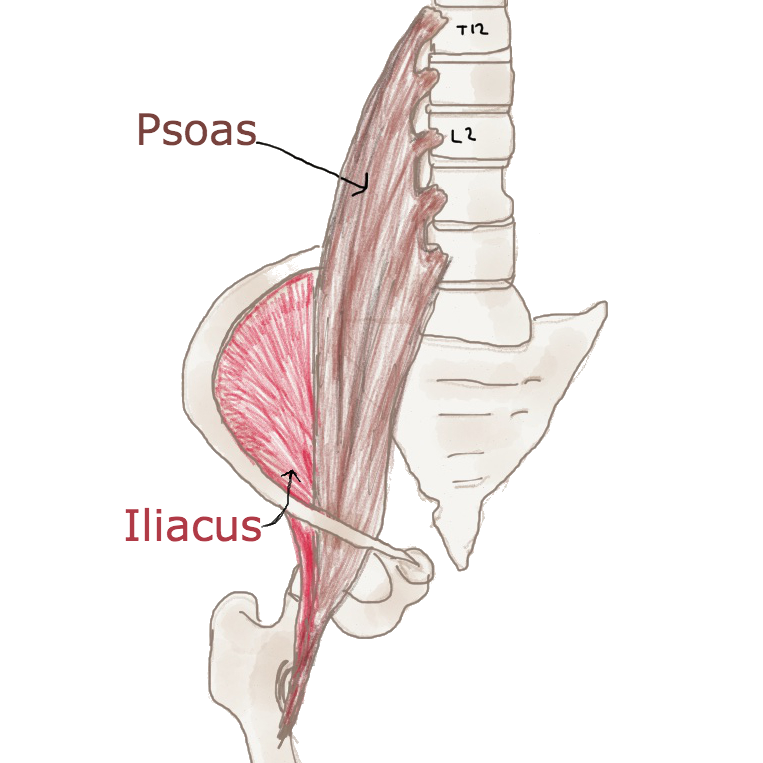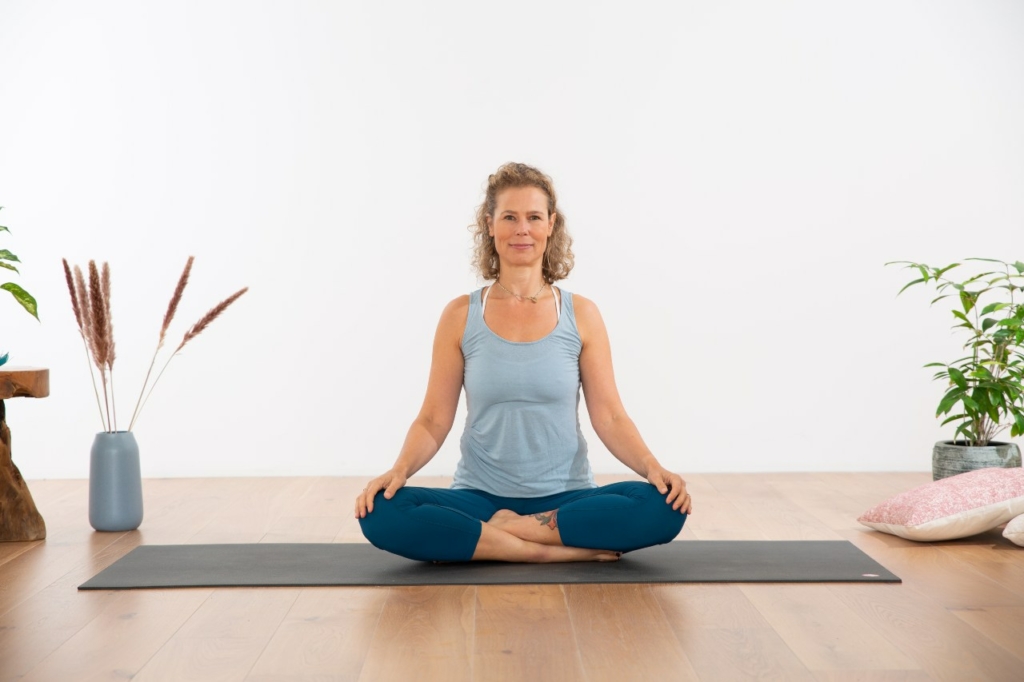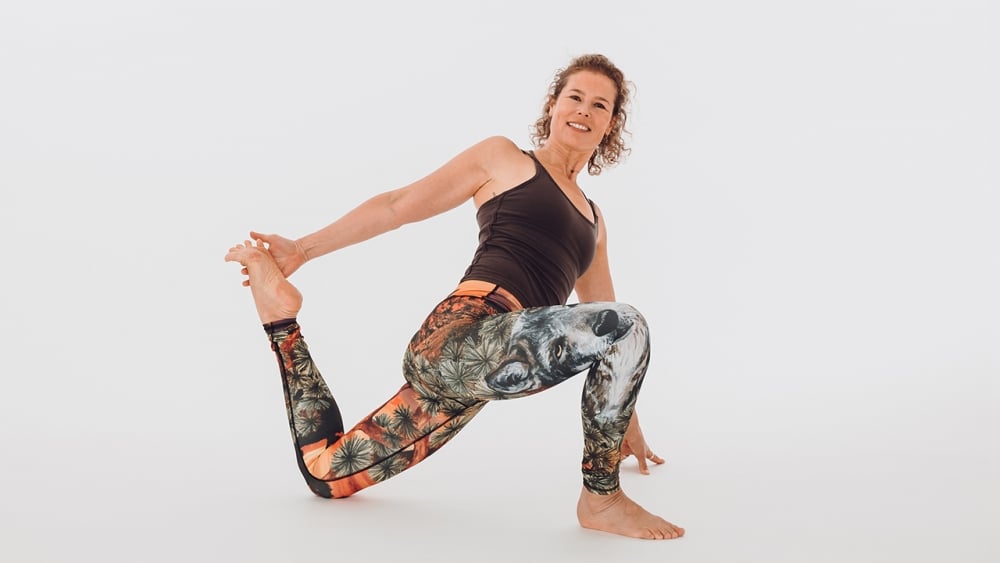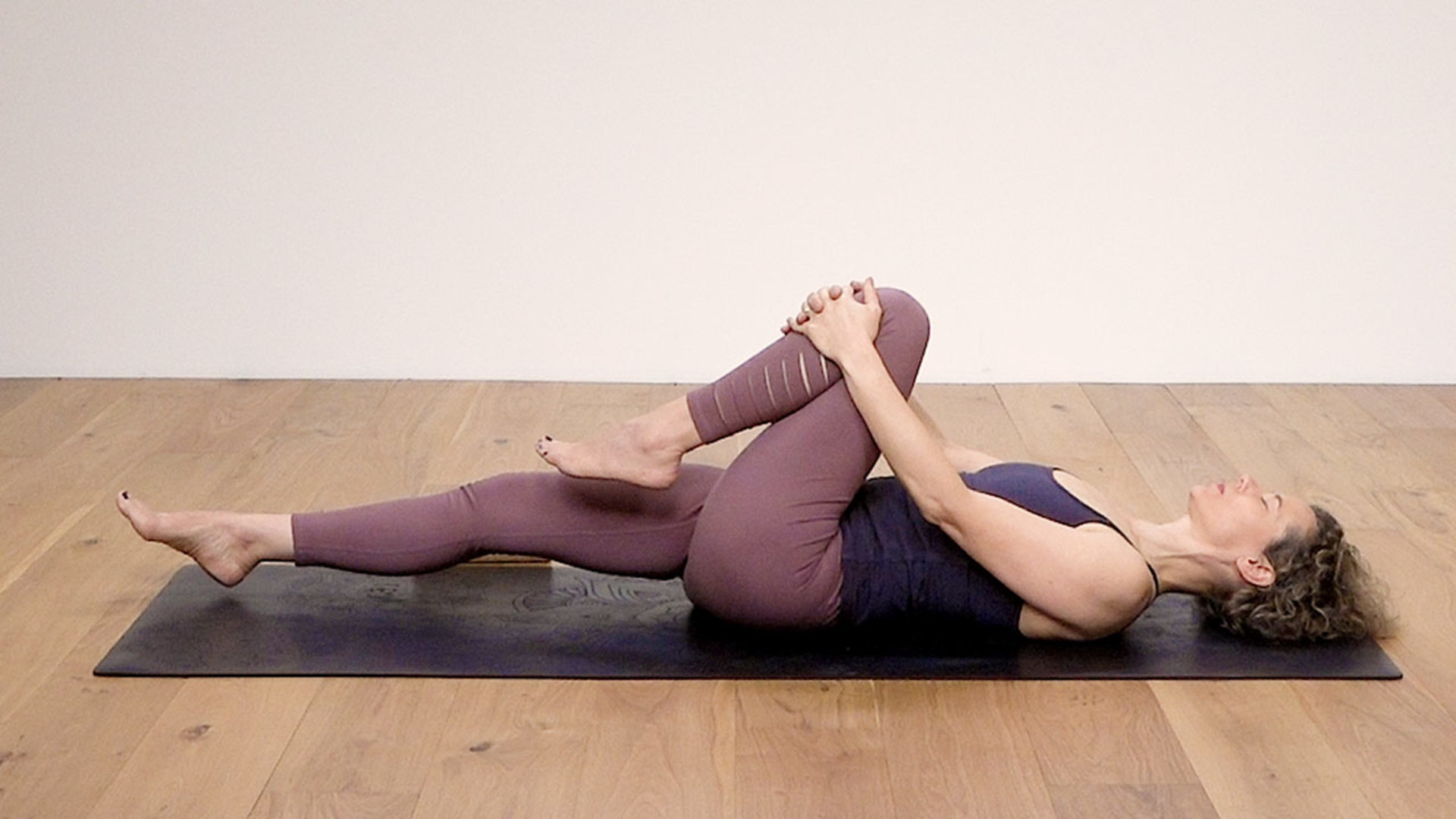The psoas is one of the strongest muscles in your body, and the effect and influence of it on the internal structure of your body is significant. Here’s how I first became aware of its power…
Some years ago, at the end of an intense Vinyasa yoga class I’d taught, something remarkable happened. I prepared my students for relaxation, moving them into reclined hip release poses. As the energy slowed down and they began letting go of their efforts, I noticed something unusual.
A few students’ bodies started to wave and tremble in their hips and legs – seemingly moving of their own accord. One student appeared visibly emotional, tears rolling down her cheeks. When I checked in with her, she said she felt sad but assured me she was fine.
You may recognise yourself in this story, as a teacher or as a student of yoga. Independent movement in your body can trigger emotions and memories. This may be expressed as shaking or trembling, deep in your pelvis. If you’ve ever experienced this, you may have just been in touch with your beautiful and mighty psoas muscle.
What is the psoas muscle?
The psoas attaches your upper body to your lower body. It is the only muscle that connects your spine to your legs. It is also one of the most fascinating and important muscles in the human body – physically, emotionally and energetically.
No matter what you do, your psoas is involved in almost every action and movement. Even your feelings and thoughts are linked to it. It is a true connector in the whole sense of the word and therefore a real ‘yogic’ muscle.
In our physical body, the psoas influences healthy and balanced posture, and is associated with stiffness in the hips and the spine. It also affects our freedom of movement when walking (and practicing yoga). Our diaphragm is subtly yet deeply linked to the psoas too, so it influences how we breathe.
In the emotional body, the psoas greatly determines the ability to relax, and influences feelings of wellbeing and stability. An awakened, relaxed and juicy psoas enables the free flow of subtle energy and increases sensitivity in the whole body.
Anatomy of the psoas muscle
Depending on which muscles you include, the number of psoai (the plural of psoas), differs. The psoas complex consists of four muscles: a psoas major and psoas minor on each side of the body. Because of our evolutionary development, growing from all fours into upright beings, the function of the psoai have changed. The psoas minor muscle is slowly turning into a tendon and may be disappearing completely; many people only have one psoas minor or none at all.

The insertion of the psoas major is in the lumbar vertebrae. It connects to all the vertebral bodies and intervertebral discs of the lower back all the way up to T12, where your lower ribs begin. Without attaching to it, the psoas runs through the pelvis and attaches to the inner upper thigh bone at the lesser trochanter.
We often describe the psoas complex as ‘the iliopsoas’ muscle because it shares the same attachment at the thigh bone with the iliacus muscle. However, the function of psoas is different from the iliacus. The origin of the iliacus is on the inside of the pelvic rim and it assists hip flexion at the pelvis. The iliacus is not involved in movement that flexes or extends the spine (bending forward or backwards).
The effects of an imbalanced psoas
The psoas runs through our pelvis but is not attached to it so its influence on pelvic alignment is not easy to measure. And since there are two separate psoai, they can be, and often are, of different lengths. They have the power to cause tilts, shifts and rotations in the pelvis. They can also cause cause sacroiliac, pelvic issues and back problems, ranging from the pelvis upwards – sometimes even all the way up to the neck.
The effect of an imbalanced psoas muscle on the lower back is direct and immediate. It can either pull the lower back into lordosis, a deeper inward curve, or the opposite, pulling the lower back flat. Either way, when the lower back is out of alignment, the rest of the spine will be indirectly but profoundly affected by the psoas. The psoas is one of the strongest muscles in your body, and the effect and influence of it on the internal structure of your body is significant.
Tightness or imbalance in the tone of the psoas can cause other (often overlooked) issues too. These include: difficulty focusing, sitting still or relaxing, irritability, sadness, anger, fatigue, problems falling asleep or sleeping well and digestive issues
How ‘toned’, or how supple and strong your psoas is greatly influences the shape of your pelvis and spine. The tone of your psoas can also affect a host of other issues that inhibit the quality of your life. At least two major factors have a determining influence on the tone or amount of tension in the psoas. These are: your habitual posture and movement, and tension or trauma in your body.
How activity can affect the psoas
A tight psoas can arise from the type of activity or inactivity that we engage in. These days, we often do sport or activities at certain times during the week, rather than moving moderately throughout the day. Lack of diverse movement or overworking certain muscle groups can distort the balance in muscle tone in your body.
This imbalance can be especially evident in people who isolate muscles during intense workouts or weight lifting. The focus on training specific muscles rather than the body as a whole stimulates muscle domination in certain muscles and muscle groups.
This muscle imbalance occurs in many sports including intensive cycling and mountain climbing, where the front body muscles are worked more dominantly than the back body muscles. In these cases, the front body muscles and hip flexors, especially the psoas muscle, develop and adapt to a permanent contracted state. As such, they have the tendency to cause back problems as the shortened psoas pulls continuously on the spine.
How inactivity can influence the psoas muscle
The psoas can also shorten through inactivity. The psoas is like a piece of strong elastic. When you stand up straight, the rope is taut, when you bend from your hips, it slackens. Whenever the hips are in flexion – e.g. when sitting and even sleeping on your side – your psoas relaxes and shortens.
When your body is habitually positioned in a certain posture, often for hours on end, this posture becomes standard. Your musculature and connective tissues will adapt to this shape. So when you sit for long periods of time, your psoas will shorten to adjust. An important point, given the fact that recent studies show that people sit on average for 12 hours a day.
Tightness in the body stems largely from tightness in the myofascia, the connective tissue which runs through the muscles. When your muscles feel tight, it is not actually your muscles that become ‘stiff’. Instead it’s the connective tissue in the muscle that stiffens up. However, when the psoas responds to stress, it is the muscle itself that gets tight. Depending on how you stretch your psoas, you can relieve the tension or make it worse.
Exploring your psoas muscle
You may be surprised to know that you can feel your psoas with your fingers. You can try this out in the following class – Psoas, sacrum and core. [If you want to go straight to the demonstration, skip to minute 16:27 of the class]. Bear in mind, that the psoas feels very different to any other muscle in your body. Although incredibly strong, it can feel delicate and you may experience a strong physical response when touching it.
It requires some exploration and practice, but you might be able to feel the psoas from the inside too. Simply lying on your mat and bringing your attention to the psoas will eventually bring awareness in a sensory way. Developing your awareness of when the psoas releases and tightens will make it easier to feel it off the yoga mat too. This is especially true in stress-inducing situations where it will tighten. At the other end of the scale, you may also feel the psoas releasing when you are relaxed.
Sensory exploration combined with yoga will increase your ability to feel the psoas and work with it in a positive way. This can include learning to relax and improving your posture. When you are well-aligned, many yoga asanas can help to stretch out this habitual tension. But other causes of a cramped psoas, such as deep-seated tension and trauma, need to be released by the psoas itself.
Body and psoas stress release class
Tension is a normal and natural thing that everyone experiences – however, it’s important that we can process it. If we don’t allow its release, we can end up with residual tension that our physical bodies hold onto long after the event that caused it. This class guides you through some simple poses and movements. It will help you to listen to your body and give you the space needed in order to release tension.
Tension, trauma and the psoas
Habitual movement patterns – especially the amount of time spent in hip flexion – can affect the amount of tension and tone of the psoas. However, deep-rooted tension is more likely the result of unreleased tension and trauma from the past.
Massaging the psoas muscle directly can be painful; some people can even get nauseous or dizzy when their psoas is touched. Tension and trauma from the past are best released by the body itself, in its own time. When a release of tension in the psoas happens, it can stimulate a spontaneous release of tension elsewhere.
The nervous system and the psoas
Simply put, the autonomic nervous system (ANS) is our body’s ‘control system’. It acts largely unconsciously and beyond our direct control. A well functioning ANS is vital to our health and supports growth and rest. The ANS also regulates the body’s response to safety and danger. It has three states. The parasympathetic state of relaxation (rest and digest), the sympathetic state of activation and defence (fight or flight) and – if neither fighting or fleeing are possible – our bodies choose a third option: to freeze.
Being able to shift effortlessly between the states is part of a healthy and well functioning body. However, the body feels most at home in the parasympathetic state of relaxation. In this state most of the energy in the body will flow to the digestive organs and the muscles will be naturally toned and relaxed.
Whenever your body senses or experiences danger, it responds by going into a heightened state of activation. The psoas is the first muscular responder when you go into the sympathetic state. It contracts in reaction to danger in preparation to either flee or fight. When the danger passes and you feel safe again, you will go back into the parasympathetic state of relaxation and rest – as long as you release the tension.
The importance of processing trauma and stress
‘Coming down’ from this increased activation state is important for your physical, emotional and mental health. However, if you are unable to process and release the stress you experienced, the tension in your psoas will remain in an activated state, even if you think you have calmed down.
This disconnection between mind and body can last for many years. Some bodies can and will accommodate a lot of tension and trauma while others cannot. The psoas is like a container; some people have a big container and others a smaller one. If not emptied out regularly, it fills up with stress, and can store years’ worth of unresolved tension.
The psoas is like a container; some people have a big container and others a smaller one. If not emptied out regularly, it fills up with stress, and can store years’ worth of unresolved tension.
The good news is that your body is fully equipped to release the tension in your psoas. So whenever you experience danger and the moment of heightened stress has passed, your psoas should, and can, naturally release and let go of the tension it is holding on its own.

Train with Sandra Carson on the EkhartYoga Academy!
If you’re interested in learning more about this fascinating topic, check out Sandra’s course, Releasing Stress and Trauma. This 5-hour online training teaches you practices to help you process trauma and stress in order to create balance, enhance resilience and enable transformation.
How to encourage the release of tension in your psoas
The key to allowing your psoas to release this built-up tension is creating a safe space and an attitude of allowance of release for your body. Sometimes the muscles in your body will spontaneously release when you feel at ease. Or when there is muscle activation or stretch (for example in a yoga class). The muscles may release by trembling, vibrating or shaking off the stress that was stored. This is a natural and healthy way of releasing tension in the psoas.
This physical release will then be able to be processed by the brain. This may cause fragmented emotions and memories to emerge. You may or may not remember the event that caused the stress. It can feel a bit strange to have strong emotions arise without knowing what caused them. And sometimes, you can directly relate it back to an event or situation.
The more you learn to access this natural processing of releasing the psoas, the more tension you let go of. When you start to release, take it slowly and gently. Releasing too much tension at once may result in you feeling a bit wobbly, fatigued and depleted in energy. Stronger emotions, such as memories of events or people may come to the surface too. Try to accept whatever arises; it is a natural part of the process.
You may experience the release differently each time it happens. Even expectations around what the release looks like or how intense it is, could inhibit the natural process of letting go. Releasing the psoas teaches you to surrender to your body. To let the psoas do what it instinctively knows how to do. Rather than interfere with your body or make it “do” something, just enjoy not being fully in control for a change!
What happens when you release tension in your psoas?
Releasing deep-seated tension may cause you to feel a little off-balance. However, the benefits of doing so far outweigh any short-lived uncomfortable sensations you may encounter.
In my experience, helping people release their psoas enables them to feel better in their body and in their life. When you learn to release stored up tension, it’s likely that your sleep and your general mood will improve. You’ll more easily be able to observe your natural boundaries. You’ll also be better equipped to avoid burnout or exhaustion in the long run.
You may also feel more energised and more at ease and at home in your body and in your life. By feeling more anchored and connected to your body, you may find you’re more able to open your heart and embrace life as it happens.
An awakened and relaxed psoas has nothing less than a magical effect on your being, embodiment and energy.
I hope you enjoy exploring it!
Love
Sandra
Related:
- Learn more about the link between your psoas and stress: Stretching out your stress
- Yoga for the psoas – stretch, release and tone
n.b. This is an edited version of Sandra’s original article, published in Om magazine.


